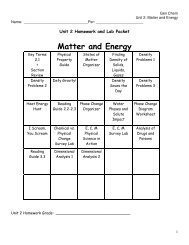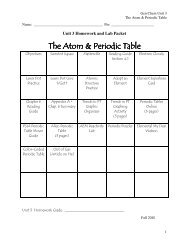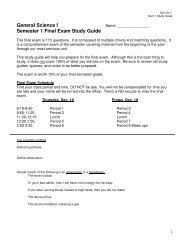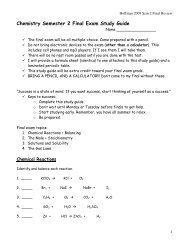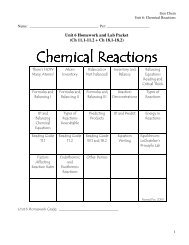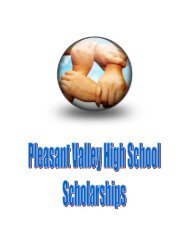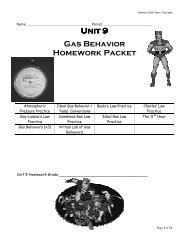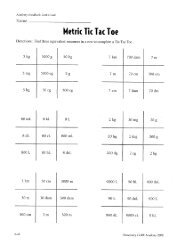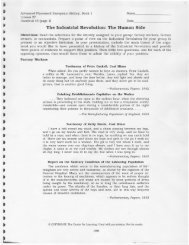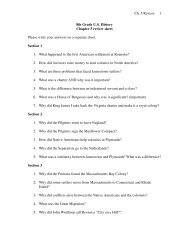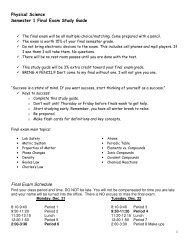Section 1-1 What is Science? (pages 3-7)
Section 1-1 What is Science? (pages 3-7)
Section 1-1 What is Science? (pages 3-7)
Create successful ePaper yourself
Turn your PDF publications into a flip-book with our unique Google optimized e-Paper software.
Chapter 1: The <strong>Science</strong> of BiologyName_______________________Period___Objectives1. Explain the goal of science2. L<strong>is</strong>t, identify and describe the purpose of the steps/components of the scientific method3. L<strong>is</strong>t, identify and describe the purpose of a controlled experiment and each of its components;experimental group, control group, independent/manipulated variable, dependent/respondingvariable, constants4. Explain how a theory develops, its function and give examples.5. Describe character<strong>is</strong>tics of living things.6. Explain how life can be studied at many levels; l<strong>is</strong>t the levels of organization from simple tocomplex7. Describe the metric system, identify units to measure length, mass and volume, and convertbetween different units of measurement8. Explain how light & electron (transm<strong>is</strong>sion and scanning) microscopes are similar and different.9. Identify the parts of a light microscope and their functions10. Be able to use proper laboratory techniques in terms of measuring, observing, and safe handling11. Other key terms: science, technology, non-science (pseudoscience), bioethics, observation,inference, hypothes<strong>is</strong>, data (qualitative &. quantitative), theory, spontaneous generation, biology,cell, reproduction (sexual & asexual), metabol<strong>is</strong>m, homeostas<strong>is</strong>, evolve, cell culture &fractionation<strong>Section</strong> 1-1 <strong>What</strong> <strong>is</strong> <strong>Science</strong>? (<strong>pages</strong> 3-7)<strong>What</strong> <strong>Science</strong> Is and Is Not (page 3)1. The goal of science <strong>is</strong> to__________________ and ________________ nature, to_________ eventsin nature, and to use those explanations to make useful _______________________.2. L<strong>is</strong>t the 3 features that make science different from other human endeavors:A. _________________________________________________________B. _________________________________________________________C. _________________________________________________________3. _______________________<strong>is</strong> an organized way of using evidence to learn about the natural world.Evidence Based on Observation (page 4)4. Observations usually involve the ____________________________________ to gather information.5. The information gathered from observation <strong>is</strong> called evidence or ____________Outline Chap 1 The <strong>Science</strong> of Biology - 1 - 8/5/2008
6. Types of observations and data:Type of Data Observations involve ExampleNumbersCharacter<strong>is</strong>tics that cannot be easilymeasured or counted (Not a specificamount)Interpreting the Evidence (page 4)6. An____________________ <strong>is</strong> a logical interpretation based on _______________ and __________.7. Examples (to be d<strong>is</strong>cussed in class):A. Observation:B. Inference based on that observation:Explaining the Evidence (page 5)8. A _______________<strong>is</strong> a proposed scientific explanation for a set of ____________ or an _________to a scientific question.9. In science, a hypothes<strong>is</strong> <strong>is</strong> useful only if it <strong>is</strong> ______________________.10. A hypothes<strong>is</strong> should be stated in a way that it can never be proved wrong. True or False?11. <strong>What</strong> are 3 ways from which hypotheses may ar<strong>is</strong>e?A. __________________________________________________________________B. __________________________________________________________________C. __________________________________________________________________12. Circle the letter of each of the following that may be an outcome of testing a hypothes<strong>is</strong>:A. The hypothes<strong>is</strong> <strong>is</strong> partly true but needs to be rev<strong>is</strong>ed.B. The hypothes<strong>is</strong> <strong>is</strong> wrongC. The hypothes<strong>is</strong> <strong>is</strong> supportedD. The hypothes<strong>is</strong> <strong>is</strong> of no valueA Scientific View of the World & <strong>Science</strong> and Human Values (<strong>pages</strong> 6-7)13. <strong>Science</strong> <strong>is</strong> an ongoing process. Qualities scient<strong>is</strong>ts should have are: _________________________________________________________________________________________________________14. <strong>Science</strong> has definite____________________.A. Examples of non-science or pseudoscience (things science cannot prove or help decide (2are l<strong>is</strong>ted in the book, come up with a 3rd on your own):o ___________________________________________________________o ___________________________________________________________o ___________________________________________________________Outline Chap 1 The <strong>Science</strong> of Biology - 2 - 8/5/2008
15. Bioethics deals with moral <strong>is</strong>sues ra<strong>is</strong>ed by science and technology. Is the following true or false?A community must use its shared values to make dec<strong>is</strong>ions about scientific <strong>is</strong>sues.<strong>Section</strong>1-2 How Scient<strong>is</strong>ts Work (<strong>pages</strong> 8-15)Designing an Experiment (<strong>pages</strong> 8-10)1. According to the “Recipe for Bees” what did you have to kill during the winter? ________________2. The idea that life can ar<strong>is</strong>e from non-living matter <strong>is</strong> called _______________________________.3. <strong>What</strong> was Francesco Redi’s hypothes<strong>is</strong> about the appearance of maggots? __________________.4. _______________________are factors that can change in an experiment.5. A hypothes<strong>is</strong> should be tested by an ______________in which only __ variable <strong>is</strong> changed at a time.Type of VariableDefinitionManipulated variable(Independent variable)Responding variable(Dependent variable)Controlled variable(Constant)6. In the diagram above, which jar (X or Y) would have developed maggots? _______7. <strong>What</strong> was the purpose of the gauze? __________________________________________________8. In Redi’s experiment what was theA. Manipulated (independent) variable? ____________________________________________B. Responding (dependent) variable? ______________________________________________9. L<strong>is</strong>t 2 controlled variables (constants) that would have been present in Redi’s experiment: ________________________________________________________________________________________Outline Chap 1 The <strong>Science</strong> of Biology - 3 - 8/5/2008
10. Scient<strong>is</strong>ts record their data and observations during an experiment. Afterwards they analyze thedata.11. Drawing a _________________________.A. Scient<strong>is</strong>ts use the data to __________________the ____________ and to draw a ________.B. The hypothes<strong>is</strong> may be _______________ or _________________ by the data.C. Redi’s results refuted the hypothes<strong>is</strong> of ___________________________________.Publ<strong>is</strong>hing and Repeating Investigations (<strong>pages</strong> 10-13)12. Anton van Leeuwenhoek looked at ______________________ and d<strong>is</strong>covered tiny animals hecalled ___________________.13. Some people still didn’t believe Redi’s experiment and continued to prove spontaneous generation.John Needham tried to prove that “animalcules” could come from _________________________.14. Spallanzani’s experiment:A. <strong>What</strong> did Spallanzani do differently than Needham with the gravy? _____________________Why? _____________________________________________________________________B. Spallanzani used two jars. How did he set the jars up differently? (<strong>What</strong> was themanipulated variable?) _______________________________________________________C. Spallanzani’s experiment showed that living things entered the gravy from where? _______D. Why did some scient<strong>is</strong>ts think the experiment was not fair? ___________________________15. Pasteur improved on Needham and Spallanzani’s experiments by:A. Leaving the flask open to the airB. Sealing the flaskC. Adding water to the flask16. <strong>What</strong> else was different about the flask neck in Pasteur’s experiment? _______________________17. Pasteur showed that all living things come from other ________________things.18. Name the scient<strong>is</strong>t credited with the d<strong>is</strong>covery:A. Blood <strong>is</strong> circulated through vessels _________________________B. Anthrax vaccine _________________________C. The structure of DNA (2 people): _________________________When Experiments are Not Possible & How a Theory Develops (<strong>pages</strong> 14-15)19. Name one reason why a controlled experiment may not be possible: _________________________20. If a hypothes<strong>is</strong> becomes very well supported, scient<strong>is</strong>ts may consider it a _____________________.21. In science, the word ____________, applies to a well tested explanation that unifies a __________range of _________________. Scient<strong>is</strong>ts can make accurate __________________ using theories.Outline Chap 1 The <strong>Science</strong> of Biology - 4 - 8/5/2008
22. The theory that new organ<strong>is</strong>ms come from ex<strong>is</strong>ting organ<strong>is</strong>ms <strong>is</strong> called ______________________23. <strong>What</strong> 2 theories help explain why some marsupials mammals are only found in Australia?____________________________ and ____________________________________24. <strong>What</strong> can happen to a theory if new evidence <strong>is</strong> found? _________________________________The blue subtitles of Appendix A: Conducting an Experiment (<strong>pages</strong> 1056-1057) l<strong>is</strong>t the usualsteps of the scientific method. Use the Appendix to complete the information below for the stepswe will use in class:1. Identify a question or_________________ you want to solve2. Gather information and develop a ______________________A. Which <strong>is</strong> an educated and ______________ explanationB. It <strong>is</strong> only useful if it __________________3. Design an _____________________________to test the hypothes<strong>is</strong>4. _________________________-data by recording & analyzing5. Draw ___________________________A. Based on dataB. Decide if hypothes<strong>is</strong> was _________________or _____________________Review and understand variables d<strong>is</strong>cussed earlier: manipulated/independent,responding/dependent, controlled variables/constants.o <strong>What</strong> <strong>is</strong> the purpose of a control group?____________________________________________________________________________________________________________________________________<strong>Section</strong> 1-3 Studying Life1. <strong>What</strong> does the word biology mean? _______________________________2. L<strong>is</strong>t the 8 character<strong>is</strong>tics of life:A. Made up of units called ____________B. _______________________________C. Based on a universal _______________D. ______________and_______________E. Obtain and use _____________________F. _________________________ to their environmentG. Maintain a __________________internal environmentH. As a group, living things ___________________over timeOutline Chap 1 The <strong>Science</strong> of Biology - 5 - 8/5/2008
3. Circle the letter of each sentence that <strong>is</strong> TRUE about cells.A. A cell <strong>is</strong> the smallest unit of an organ<strong>is</strong>m that <strong>is</strong> considered alive.B. A multicellular organ<strong>is</strong>m may contain trillions of cells.C. A living thing that cons<strong>is</strong>ts of a single cell <strong>is</strong> a multicellular organ<strong>is</strong>m.D. Organ<strong>is</strong>ms are made up of cells4. A type of ______________________ reproduction where a portion of an organ<strong>is</strong>m splits off to form anew organ<strong>is</strong>m <strong>is</strong> called ___________________.5. ______________________ reproduction requires 2 parents6. ______________________ reproduction requires only 1 parent7. The universal genetic code and the directions for inheritance are carried by a molecule called__________________________________________ or __________ for short.8. <strong>What</strong> <strong>is</strong> the difference between growth & development? ___________________________________9. <strong>What</strong> <strong>is</strong> metabol<strong>is</strong>m? _______________________________________________________________10. Plants, some bacterial and most algae obtain their energy directly from _____________________.11. Why does an organ<strong>is</strong>m need energy & a constant supply of materials? _______________________12. A stimulus or change in the environment <strong>is</strong> a signal to which an organ<strong>is</strong>m ____________________.13. Give 2 examples of external (environmental) stimuli: _____________________________________13. The process by which organ<strong>is</strong>ms maintain constant internal conditions if referred to as___________.14. ____________________ <strong>is</strong> when a group of organ<strong>is</strong>ms change over time.Branches of Biology (<strong>pages</strong> 20-21)15. There are many kinds of biolog<strong>is</strong>ts. <strong>What</strong> <strong>is</strong> the term for a biolog<strong>is</strong>t who studies the following:a. Studies animals <strong>is</strong> called a ______________________b. Studies plants <strong>is</strong> referred to as a __________________c. Studies ancient life <strong>is</strong> a _________________________16. Referring to Figure 1-21 “Levels of Organization” on page 21, in your book, answer the following:a. The smallest functional unit of life <strong>is</strong> the _______b. Groups of cells working together form (molecules or t<strong>is</strong>sues)-circle one.c. An ___________________ <strong>is</strong> a community and its nonliving surroundings.d. An ___________________ <strong>is</strong> an individual living thing.e. The __________________ <strong>is</strong> the part of the earth that contains all ecosystems.17. Write the levels of organization from smallest to largest: _________________________________________________________________________________________________________________Outline Chap 1 The <strong>Science</strong> of Biology - 6 - 8/5/2008
18. Again referring to Figure 1-21, label each of the illustrations below according to the level of studyrepresented:A. Flock of geese <strong>is</strong> a B. Single goose <strong>is</strong> an C. Geese and f<strong>is</strong>h that live in the______________ _______________ same pond are a ___________D. Geese, f<strong>is</strong>h, water and dirt arean _____________________.<strong>Section</strong> 1-4 Tools & Procedures (<strong>pages</strong> 24-28)1. Why do scient<strong>is</strong>ts need a common system of measurement? ________________________________2. Scient<strong>is</strong>ts usually use the __________ system of measurement which <strong>is</strong> based on multiples of _____3. Complete the following equations:a. 1000 meters = 1 ___________________b. 1 liter = ________ millilitersc. 1 gram = ________ milligrams4. The meter <strong>is</strong> used to measure ______________________________5. kg stands for what unit of measurement? ______________________6. Complete the following table. Examples of each category are shown. If needed, also refer toAppendix C p.1063.UNITTOOLLengthLiter (L), milliliter (ml), cubic centimeters (cm 3 )Balance, scaleDegrees Celsius ( o C)Outline Chap 1 The <strong>Science</strong> of Biology - 7 - 8/5/2008
Analyzing Biological Data (page 25)7. Scient<strong>is</strong>ts may record data from an experiment in a ____________ and then make a ____________.8. <strong>What</strong> does a graph make easier to recognize and understand than a table of data? ______________9. Using Figure 1-24 on page 25, at what time of day <strong>is</strong> the rate of water released by leaves equal to therate absorbed by the roots? ___________________________Microscopes & Laboratory Techniques & Safety (<strong>pages</strong> 25-28)10. __________________ are devices that produce _____________ images of objects too __________to be seen by the unaided eye.11. Complete the following table:Type of Microscope <strong>What</strong> <strong>is</strong> Used to Focus Advantages D<strong>is</strong>advantagesLightTransm<strong>is</strong>sion Electron(TEM)Scanning Electron(SEM)NOTE: You are responsible for knowing the microscope parts and their functionsin Appendix D “Use of the Microscope” on <strong>pages</strong> 1064 -1065, even though thereare no questions in th<strong>is</strong> reading guide.12. Refer to the Analyzing Data box at the top of page 27 to answer the following:a. <strong>What</strong> variable did the researcher change (manipulated variable) during the experiment? ____b. <strong>What</strong> do the shapes of the curves tell you about the changes in population at differenttemperatures? _____________________________________________________________c. Suppose some bacteria were kept at a temperature of 100 o C (the temperature of boilingwater). Would you expect the population sizes to increase even faster than at 15 o C? Explainyour reasoning. ____________________________________________________________13. A group of cells grown in a nutrient solution from a single original cell <strong>is</strong> called a ________________.Outline Chap 1 The <strong>Science</strong> of Biology - 8 - 8/5/2008
14. A technique called ________________ <strong>is</strong> used to separate one part of a cell from the rest of the cell.15. Before you start any lab activity, ___________ all the steps and make sure that you _____________the entire procedure, including any __________________ precautions that must be followed.16. <strong>What</strong> <strong>is</strong> the single most important rule for your safety? _____________________________________17. It <strong>is</strong> essential that you _______________ your hands thoroughly after every scientific activity.WordW<strong>is</strong>e: The block of letters below contains six vocabulary terms from Chapter 1. Usethe clues to identify the words you need to find. Then, find the words across,down, or on the diagonal. Circle each word in the hidden-word puzzle.CluesVocabulary Terms1. A device that produces magnified images of structures _________________________that are too small to see with the unaided eye2. A well-tested explanation that unifies a broad range of _________________________observations3. Change over time _________________________4. The process by which organ<strong>is</strong>ms keep their internal _________________________conditions fairly constant5. An organized way of using evidence to learn about _________________________the natural world6. Evidence gathered from observations _________________________7. The chemical reactions through which an organ<strong>is</strong>m _________________________builds up or breaks down materials8. A collection of living matter enclosed by a barrier that _________________________separates it from the surroundingsh o m e o s t a s i sh n s q a a l e s n mm t c e l l s v m s sh y i d o s z o u p bt m e t a b o l i s mr w n l s t x v m s sm i c l s v a e d a ht h e o r y l m e a nm m i c r o s c o p elStudy Tips:1. Review the objectives at the beginning of th<strong>is</strong> reading guide. Also reread your notes while you skimthe chapter.2. Review questions at the end of each section and at the end of the chapter3. Review Appendices on the scientific method p. 1056 – 1057, the metric system 1063, the microscope1064 – 1065, and lab safety 1060 -1062.4. Take online practice quiz at http://biologycorner.com/bio1/chap1_qz.html5. Quiz yourself using the vocabulary words in bold print throughout the chapter, on crossword puzzlesand vocabulary review sheets6. Study!!Outline Chap 1 The <strong>Science</strong> of Biology - 9 - 8/5/2008



